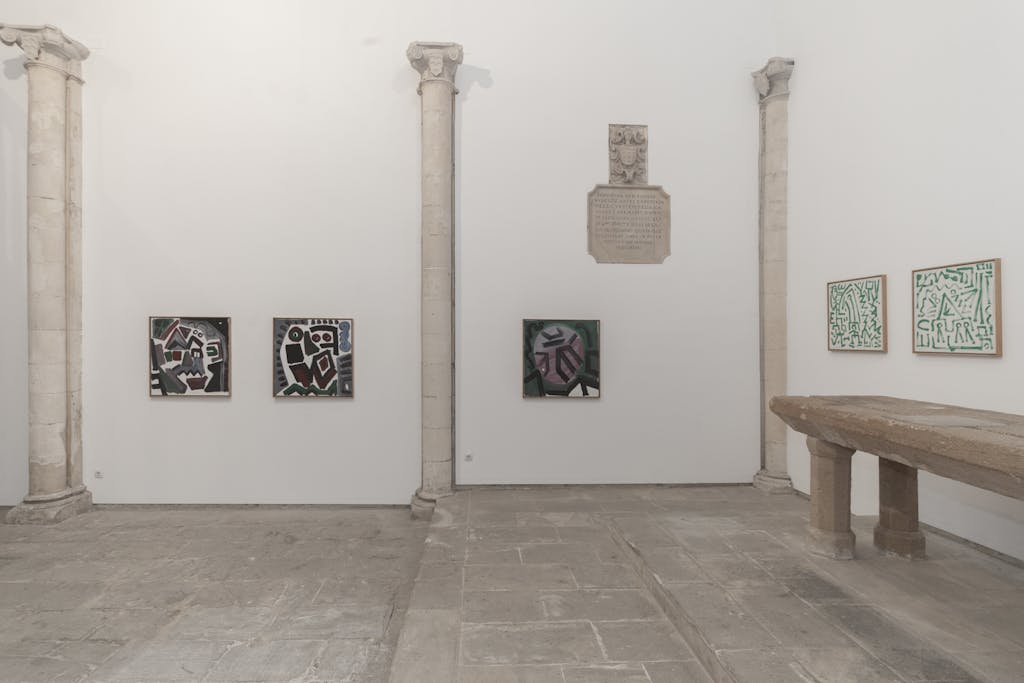Penck, born 1939, known by his civic name as Ralf Winkler, grew up in bombed-out, post-war Dresden. He found his playgrounds amongst the ruins, created from the firing bombs of the allies, which afflicted the city like no other in Germany, like a horror film in consciousness. He began to paint and draw at 10 years of age and knew early on that he was an artist. He was unable however to impress the GDR State, founded in 1949. He was expelled from high school, and was later on not accepted into university. The Artist's Association, which officially determined who could be an artist in the GDR, rejected him because he did not fit into the socialist ethic and aesthetic. Despite the constant threat and disturbance from the Stasi (the secret service of the GDR), Penck became an underground artist, who conquered the art scene in western Europe from afar, and with his un-surpassingly powerful painting, reclaimed space at Documenta, in which conceptual art and minimalism had otherwise governed. Penck's galerist, Michael Werner and his then wife Jule (now Kewenig), smuggled his art into the west, whilst according him forbidden music, books and West German Marks. With this, Penck built his counter-world. Once the situation for him became unbearable, he migrated to the west in 1980, became an immigrant, was nowhere at home, a wanderer between worlds. Nonetheless, his art had already preceded him, he quickly asserted himself in the Cologne art scene - back then one of the worlds most significant - as a central figure. Beanie, speckled jeans, wild beard, piercing laugh: Penck! And his first exhibition in 1981 in New York at the legendary Ileana Sonnabend, meant the breakthrough into the USA, for German painting as a whole.
Penck came all the way to the top, the MoMA and the Tate Modern purchased his works well into the late 1990s, and he was rarely missing in any significant exhibition. But then he simply turned his back on the art world and disappeared. Barely anybody could reach him. In 2015 he survived a stroke, after which his hands no longer wanted to be quite right, but his spirit and eyes were alive like always. He accompanied a large exhibition in the Fondation Maeght in 2017 from afar, before his heart in May, opted out.
But actually Penck did not really die, for his artworks are preserved. They confirm his leading role in European Post-War Art. The works pass on to us not so much of the homo-politicus, the German, or the immigrant, but rather a brilliant artist, who regardless where and in which situation, with manic zeal, pursued only one goal: the visualisation of his ideas, experiences and dreams. For those who wish for a little visual reference to Penck's mysterious images, can venture to look at the brushstroke. The selection of works shown at Kewenig Palma gives a small overview into Penck's work, marking an arch in the TM and Y series, from the wild underground years in the East, through the colourful 80s paintings from the West (e.g. G.B. 5), to his later works. How lusciously Penck at times dove his paintbrushes into the paint to seal the paintings surface, like with Gegen-Stand from 2013. Then again, see Y from 1978, where he paints so thinly, that a white space seems to appear behind the figures and signs. At other times he draws on all registers, like with Standart TTABTTT 4 from 1984, letting the brush tremble and splodge... Each of these strokes Penck conceived and carried out. Here his life continues.
